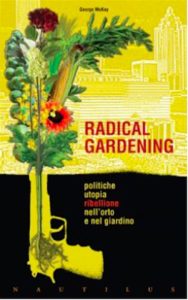Certain gardens are described as retreats when they are really attacks. — Ian Hamilton Finlay
Social historians hardly ever mention gardens or gardening, and garden historians have little to say generally about politics. — Martin Hoyles, The Story of Gardening

Radical Gardening: Politics, Idealism and Rebellion in the Garden was published by leading independent gardening publisher Frances Lincoln in May 2011. (I think FL has been swallowed up a publishing giant since.) The book was widely and highly favourably reviewed. A Google Book open access version of some of it is available here (do I get royalties or a fee for that?).
Alas it’s now out of print. There was talk from the publisher of an e-book some years ago but that didn’t seem to happen. Practically weekly I receive an email from round the world asking for a copy. (Do get in touch.) I have often thought of a revised updated edition, to include a new chapter looking at gardening, the climate emergency, and the radical claims of ‘rewilding.’
From the introduction (which by the way you can read in full here):
… Radical Gardening is about the idea of the ‘plot’, and its alternate but interwoven meanings (there are three). Many of the plots we will explore are inspiring, and allow us to see how notions of utopia, of community, of activism for progressive social change, of peace, of environmentalism, of identity politics, are practically worked through in the garden, in floriculture, and through what Paul Gough has called ‘planting as a form of protest’. But not all—some are sobering, or frightening, for within the territory of the politically ‘radical’ there have been and continue to be social experiments and articulations that invert our positive expectations of the human exchange that occurs in the green open space of a garden.

The book is modest in its ambitions: all I want to do is to convince you, dear reader-gardener, that those notions of a horticountercultural politics you suspected were in your earthy practice and pleasure (I agree that you probably didn’t called them horticountercultural politics) have a rich and challenging tradition, a significance, as well as a trajectory of energy and import that makes them matter for our future.
‘Why’, asks writer-gardener Jamaica Kincaid, ‘must people insist that the garden is a place of rest and repose, a place to forget the cares of the world, a place in which to distance yourself from the painful responsibility with being a human being?’ I follow Kincaid, and join the likes of Martin Hoyles, Paul Gough, Kenneth Helphand and others, each of whose work on gardens has helped shape my own thinking, in insisting on a view of the garden which allows us to include the opposite.
 Such a reading of the garden should not be a strange or forced juxtaposition of plant and ideology: think only of the English radical writer William Cobbett, who declared in 1819 that ‘if I sowed, planted or dealt in seeds; whatever I did had first in view the destruction of infamous tyrants’. Or think of the etymology of the word propaganda—which today refers to the organized art of political persuasion—deriving from the Latin verb propagare, to propagate. Or the twentieth century revolutionary playwright Bertolt Brecht who observed, with startling accusatory power, that ‘famines do not occur, they are organized by the grain trade’. Or the female Colombian activist speaking to western buyers on behalf of the 40,000 women working in the pesticidal contemporary Colombian flower industry: ‘Behind every beautiful flower is a death. Flowers grow beautiful while women wither away’.
Such a reading of the garden should not be a strange or forced juxtaposition of plant and ideology: think only of the English radical writer William Cobbett, who declared in 1819 that ‘if I sowed, planted or dealt in seeds; whatever I did had first in view the destruction of infamous tyrants’. Or think of the etymology of the word propaganda—which today refers to the organized art of political persuasion—deriving from the Latin verb propagare, to propagate. Or the twentieth century revolutionary playwright Bertolt Brecht who observed, with startling accusatory power, that ‘famines do not occur, they are organized by the grain trade’. Or the female Colombian activist speaking to western buyers on behalf of the 40,000 women working in the pesticidal contemporary Colombian flower industry: ‘Behind every beautiful flower is a death. Flowers grow beautiful while women wither away’.
 Such horticultural glimpses as these show us that there is, potentially at least, a lengthy tradition of radical gardening, and this book is meant as one contribution to maintaining and (re)constructing that tradition…
Such horticultural glimpses as these show us that there is, potentially at least, a lengthy tradition of radical gardening, and this book is meant as one contribution to maintaining and (re)constructing that tradition…
Radical Gardening was made possible by a small grant (£1000; 2009) from the Stanley Smith (UK) Horticultural Trust, for which I am very grateful—if you like the pictures in the book, their variety and presence was supported by the Trust.
Articles by, and media features with, the author about Radical Gardening
 Reviews of the book are located here but below are links to some pieces I have written, or features and interviews with me, about it.
Reviews of the book are located here but below are links to some pieces I have written, or features and interviews with me, about it.
The Independent (May 2, 2011) ‘Radical plots: the politics of gardening’
Gardens can captivate, relax and delight. But they have also been the setting for political statements and bloody protests. George McKay argues that we must dig beneath the flowerbeds and see the turf wars instead….
BBC Radio4 Thinking Allowed (4 May, 9 May 2011)
Gardening is the epitome of a peaceful pastime, associated as it is with semi-somnolent suburban weekends, the sound of hedges being carefully clipped  and the reassuring aroma of freshly mown grass. The notion of ‘radical’ gardening implies little more than a concerted attack on the mass of weeds accumulated in an herbaceous border or a garden makeover culminating in a fully decked patio. However, there is a radical history to gardening and it has been the site of protest and counterculture in Britain from the Levellers and the Diggers in the 17th century to today’s so-called Guerrilla Gardeners. On today’s Thinking Allowed Laurie is joined by George McKay and Tim Jordan to discuss the protest, politics and plots of the garden.
and the reassuring aroma of freshly mown grass. The notion of ‘radical’ gardening implies little more than a concerted attack on the mass of weeds accumulated in an herbaceous border or a garden makeover culminating in a fully decked patio. However, there is a radical history to gardening and it has been the site of protest and counterculture in Britain from the Levellers and the Diggers in the 17th century to today’s so-called Guerrilla Gardeners. On today’s Thinking Allowed Laurie is joined by George McKay and Tim Jordan to discuss the protest, politics and plots of the garden.
STIR magazine (15 August 2011), ‘Sod it! Radical gardening?’
When I began writing my new book Radical Gardening I was really struck by the words of the contumacious gardener-artist Ian Hamilton Finlay, from the independent green space he renamed Little Sparta in the Scottish lowlands: ‘Certain gardens are described as retreats when they are really attacks’. But how can a garden be an attack, a flower a critique, a trowel an agent of social change?
In my new book Radical Gardening, I look not only at liberal or revolutionary movements and their uses of gardens, but also at reactionary and xenophobic radicalisms. I ask how (far) can we say that there was such a thing as fascist gardening, for instance? And, soberingly, in what ways do racist and xenophobic groups continue to use the garden, plants and planting—and, as we will see, trees—to spread their ideas?

28 replies on “Radical Gardening”
Dear David
that book is out of print now, has been for a few years I think. Most weeks I receive a request like yours! I wish they would republish it. If you email me direct I will send you a pdf of the final proofs (not for wider dissemination).
Best wishes, George
george.mckay@uea.ac.uk
Dear George Recently I stumbled across Radical Gardening, which is referenced in the publication “On the Necessity of Gardening: An ABC of Art, Botany and Cultivation”. It seems like it would be a valuable reference for my current work in a community garden in a (politically) stigmatised neighbourhood in Copenhagen. Like others who have commented here, I’m struggling to find a copy – is there any way of purchasing the book directly from you? Best wishes, David
Andy, thanks for your interest. That book is out of print alas. If you send me an email to george.mckay@uea.ac.uk and I will send you a pdf of the original proofs, not for wider dissemination. I hope that would be helpful–Best wishes, George
Hi George, like others I’ve been looking for a copy of Radical Gardening at a not extortionate price with no luck. Might I be so cheeky as to request a pdf copy.
Hi George I love the sound of this and have been trying to find it but unsuccessfully.
Dear Ciarán, I may be able to send you a pdf, check your inbox. Thanks for your interest. Not sure I know Margaret Willes’ book ,so I will look out for that. George
Hi George,
I have just finished Margaret Willes’ The Gardens of the British Working Class and discovered Radical Gardening via the Guardian gardening podcast while digging around for my next read. Frustratingly, it’s not available in my library and I’m having little luck tracking down a copy for sale. Do you have any idea where I might be able to get my hands on one?
All best, Ciarán
Thank you Emiliano. That book is out of print now. (I have thoughts of a revised, new edition.) But I will send you a pdf copy. I hope you find it of interest. Do send a photograph or two of your work in Mexico City. Best wishes, George
Hello, George.
Emiliano here from Mexico city. I have been looking for your book everywhere, in libraries and bookstores from many different countries.
I am a visual artist working with wastelands in mexico city. It would be amazing to explore your book, but I am very sad I am not able to get a copy. Is there a way I can purchase a copy directly with you. It would mean a lot for me.
Thanks in advance.
Picked up a reference-only copy of your book in a local coffee shop and am now determined to hunt one down for myself (assuming it is now out of print?). Discovered we did the same undergrad degree at Hull College of H.E. (combined geography and socio-historical studies myself) at Inglemire Ave, although I graduated in 1982. Great course content and I particularly enjoyed lectures by Derek Crothall, Laurie Cross and Peter Crampton , amongst others. I also studied community music up in Hull (much later though) part of which involved interviewing the great Ben Higham at Community Music East, who I see you collaborate musically with. It’s a small world!
[…] The debate itself was really interesting and it gave me a lot of food for thought (excuse the pun) I don’t want to give too much away before it is released on Wednesday but we talked about the political history of Allotments and the reasons why they are different from growing stuff in your own garden. Also there was the lovely Lia Leendertz (on the phone) and the very interesting George McKay author of Radical Gardening: Politics, Idealism and Rebellion in the Garden http://georgemckay.org/radical-gardening/ […]
[…] for answers. But I am quite tempted to seek solace and sanctuary in the garden. Although (as Radical Gardening points out) Ian Hamilton Findlay […]
😀
Many thanks!
Thank you, Melanie, for your kind and considered words in the piece. Of course in the immodest world of contemporary social media I have tweeted and FB’d links to your blog entry already! George
Dear George,
Your book has been a great inspiration to me in terms of my thinking around environmental political theory. So whilst doing an internship at an NGO called Shared Assets, I wrote a blog post that deals with Radical Gardening.
Please have a look!
http://www.sharedassets.org.uk/inspiration/on-the-political-potential-of-urban-gardening/
Kind Regards!
[…] http://georgemckay.org/radical-gardening/ […]
[…] Radical Gardening: Politics, Idealism and Rebellion in the Garden (George McKay, 2011) valottaa kaikenlaisen puutarhahoidon historiaa yhteiskunnallisesta perspektiivistä. Miksi puutarhahoito on pohjimmiltaan yhteiskunnallisesti radikaalia, jopa vallankumouksellista toimintaa? […]
[…] I have just begun reading this book […]
[…] by the account in George McKay’s Radical Gardening and a recent edition of The Reunion, yesterday I ventured off to find the site of the Greenham […]
[…] (3) Read something academic but right out of your area. I always have a few books that are apparently nothing to do with what I’m currently doing. Right now for example I’m dipping in and out of George Mackay’s book on radical gardening. […]
[…] by the account in George McKay’s Radical Gardening and a recent edition of The Reunion, yesterday I ventured off to find the site of the Greenham […]
[…] in soil – and/or in the gardens that it makes possible – include increasing recognition of the political and therapeutic and dimensions of gardening. Particularly interesting expressions of the latter are […]
[…] you like the idea of gardening as a way of protest, you should check out George McKay’s new book “Radical Gardening: Politics, Idealism, and Rebellion in the Garden”. He collects ways in which […]
A great book. Joseph Beuys’ 7000 oaks artwork was my first radical gardening experience. I have had an allotment for 5 years and start thinking how to make it one of my art statements. I started a group on Facebook Gardeners’ arty chock. I promoted your book there! And will do on Twitter too. All the best with it.
[…] through the history and politics of various gardening activities which tend to the alternative. George McKay offers a counter-balance to the wealth of accounts of more staid horticultural practices and […]
April, I hope you enjoyed the evening at the Garden Museum. Did we meet and talk?
Just booked for McKay talk at garden Museum next Tuesday, 12 july 2011 and looking forward to it with interest. Sounds just nicely up the garden path away from traditional conformity.
I am going to order the book now. It looks like a very good read. Am a horticultualist/gardener and have branched into Environmental Management – studying at Birkbeck.